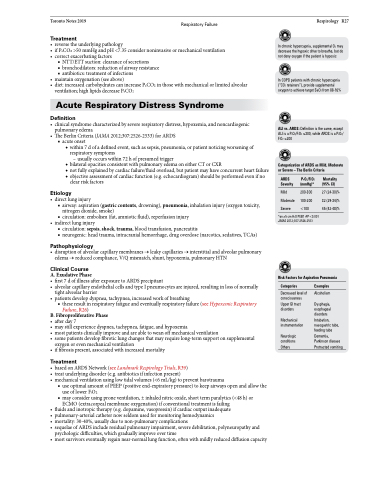Page 1273 - TNFlipTest
P. 1273
Toronto Notes 2019 Respiratory Failure
Treatment
• reversetheunderlyingpathology
• if PaCO2 >50 mmHg and pH <7.35 consider noninvasive or mechanical ventilation • correct exacerbating factors
■ NTT/ETT suction: clearance of secretions
■ bronchodilators: reduction of airway resistance ■ antibiotics: treatment of infections
• maintain oxygenation (see above)
• diet: increased carbohydrates can increase PaCO2 in those with mechanical or limited alveolar
ventilation; high lipids decrease PaCO2
Acute Respiratory Distress Syndrome
Definition
• clinicalsyndromecharacterizedbysevererespiratorydistress,hypoxemia,andnoncardiogenic pulmonary edema
• TheBerlinCriteria(JAMA2012;307:2526-2533)forARDS ■ acute onset
◆ within 7 d of a defined event, such as sepsis, pneumonia, or patient noticing worsening of respiratory symptoms
– usually occurs within 72 h of presumed trigger
◆ bilateral opacities consistent with pulmonary edema on either CT or CXR
◆ not fully explained by cardiac failure/fluid overload, but patient may have concurrent heart failure ◆ objective assessment of cardiac function (e.g. echocardiogram) should be performed even if no
clear risk factors
Etiology
• directlunginjury
■ airway: aspiration (gastric contents, drowning), pneumonia, inhalation injury (oxygen toxicity,
nitrogen dioxide, smoke)
■ circulation: embolism (fat, amniotic fluid), reperfusion injury
• indirectlunginjury
■ circulation: sepsis, shock, trauma, blood transfusion, pancreatitis
■ neurogenic: head trauma, intracranial hemorrhage, drug overdose (narcotics, sedatives, TCAs)
Pathophysiology
• disruptionofalveolarcapillarymembranes→leakycapillaries→interstitialandalveolarpulmonary edema → reduced compliance, V/Q mismatch, shunt, hypoxemia, pulmonary HTN
Clinical Course
A. Exudative Phase
• first7dofillnessafterexposuretoARDSprecipitant
• alveolarcapillaryendothelialcellsandtypeIpneumocytesareinjured,resultinginlossofnormally
tight alveolar barrier
• patients develop dyspnea, tachypnea, increased work of breathing
■ these result in respiratory fatigue and eventually respiratory failure (see Hypoxemic Respiratory Failure, R26)
B. Fibroproliferative Phase
• afterday7
• maystillexperiencedyspnea,tachypnea,fatigue,andhypoxemia
• mostpatientsclinicallyimproveandareabletoweanoffmechanicalventilation
• somepatientsdevelopfibroticlungchangesthatmayrequirelong-termsupportonsupplemental
oxygen or even mechanical ventilation
• iffibrosispresent,associatedwithincreasedmortality
Treatment
• basedonARDSNetwork(seeLandmarkRespirologyTrials,R39)
• treatunderlyingdisorder(e.g.antibioticsifinfectionpresent)
• mechanicalventilationusinglowtidalvolumes(<6mL/kg)topreventbarotrauma
■ use optimal amount of PEEP (positive end-expiratory pressure) to keep airways open and allow the use of lower FiO2
■ may consider using prone ventilation, ± inhaled nitric oxide, short term paralytics (<48 h) or ECMO (extracorpeal membrane oxygenation) if conventional treatment is failing
• fluidsandinotropictherapy(e.g.dopamine,vasopressin)ifcardiacoutputinadequate
• pulmonary-arterialcatheternowseldomusedformonitoringhemodynamics
• mortality:30-40%,usuallyduetonon-pulmonarycomplications
• sequelaeofARDSincluderesidualpulmonaryimpairment,severedebilitation,polyneuropathyand
psychologic difficulties, which gradually improve over time
• mostsurvivorseventuallyregainnear-normallungfunction,oftenwithmildlyreduceddiffusioncapacity
Respirology R27
In chronic hypercapnia, supplemental O2 may decrease the hypoxic drive to breathe, but do not deny oxygen if the patient is hypoxic
In COPD patients with chronic hypercapnia (“CO2 retainers”), provide supplemental oxygen to achieve target SaO2 from 88-92%
ALI vs. ARDS: Definition is the same, except ALI is a PaO2/FiO2 ≤300, while ARDS is a PaO2/ FiO2 ≤200
Categorization of ARDS as Mild, Moderate or Severe – The Berlin Criteria
ARDS PaO2/FiO2 Severity (mmHg)*
Mild 200-300 Moderate 100-200 Severe <100
*on ≥5 cm H2O PEEP, #P<0.001 JAMA 2012;307:2526-2533
Mortality (95% CI)
27 (24-30)% 32 (29-34)% 45 (42-48)%
Risk Factors for Aspiration Pneumonia
Categories
Decreased level of consciousness Upper GI tract disorders
Mechanical instrumentation
Neurologic conditions Others
Examples
Alcoholism
Dysphagia, esophageal disorders Intubation, nasogastric tube, feeding tube Dementia, Parkinson disease Protracted vomiting


